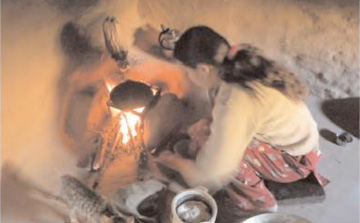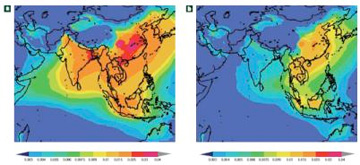Tracking the giant black carbon footprint in the Himalayas just became a whole lot easier. Using simple cell phone cameras, scientists have brought microscopic air pollutants into plain view for local people. In a study from the Scripps Institute of Oceanography at the University of California, San Diego, V. Ramanathan and colleagues are working with local villagers in Northern India to monitor local atmospheric levels of black carbon, using photographs of quartz filters taken with cell phone cameras.
Presenting their findings at the American Geophysical Union meeting in December 2010, the team discussed the impact of reducing particulate carbon emissions, also known as black carbon. The main component of soot, black carbon is generated by biomass burning and has been implicated in melting glacial ice, disrupting monsoon cycles, and worsening respiratory diseases like asthma. Black carbon particles, along with gases other than carbon dioxide, account for about half of the global emissions that contribute to climate change.
 Project Surya aims to eliminate the soot produced by traditional stoves that burn wood and dung, like this one (Photo by V. Ramanathan)
|
Unlike carbon dioxide, which lasts in the atmosphere for centuries, black carbon’s impact only lasts a few decades. Therefore cutting back on black carbon emissions can make a big difference to air quality. Eliminating one ton of black carbon could mitigate as much global warming as reducing 250 to 3000 tons of carbon dioxide, according to theoretical calculations.
The UC San Diego team is putting their sensors to work in a unique scientific intervention project, dubbed Project Surya, which is using ubiquitous cell phones to improve air quality and health in rural communities. Project Surya aims to replace soot-emitting stoves with clean burning fuels in the homes of 50,000 villagers, while tracking improvements in air quality. Each home monitors their air quality with their cell phone cameras, and reduces their carbon footprint by using the clean cook stoves.
Using the sensors is as simple as matching paint colors on a card. An air sampler fitted with a filter traps airborne carbon, growing darker as soot levels increase, and a snapshot of the filter suffices to estimate black carbon levels.
“I think this can be one of the more powerful ways to experience the world around us. I saw that personally when I started collecting black carbon data in my backyard, and just saw how black the filters were. It made much more of an impact than just hearing that there was a 2 microgram per cubic meter concentration of black carbon—that means nothing to most of us” says Nithya Ramanathan, who designed the cell phone based platform for black carbon measurements.
When reducing a footprint this size, it certainly helps to engage an entire village—or several thousand of them, armed with cameras and clean-burning alternative fuels. It doesn’t just end with a few villages, though. Wireless phones are nearly everywhere, and tapping users to collect images and data not only widens the database available to scientific research, it also engages the individuals who affect the necessary changes.
Informal data collection projects, such as this, could extend from analyzing road conditions and atmospheric smog to monitoring seabird colonies and animals in the wild. Ultimately, the real power of these cell phone based applications is in linking the origins of climate change and the solutions, simply by bringing the world around us to our attention.
Jyoti Madhusoodanan is a freelance science writer based in the Bay Area, CA.
Related articles








